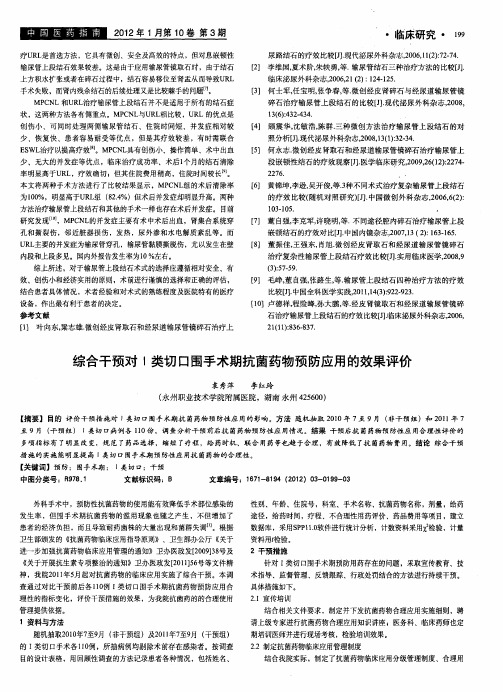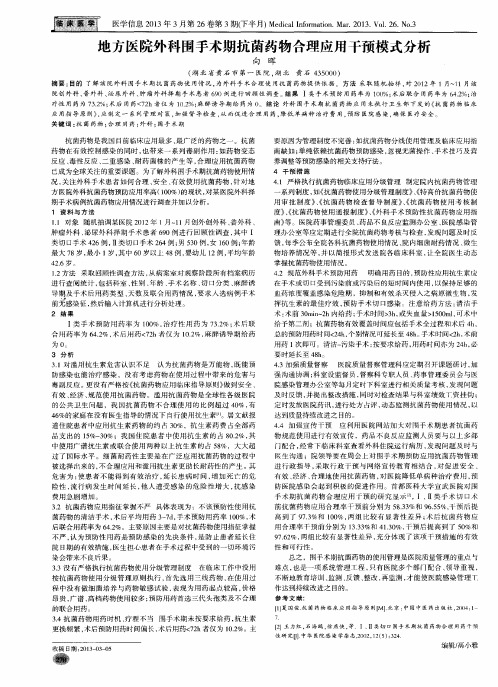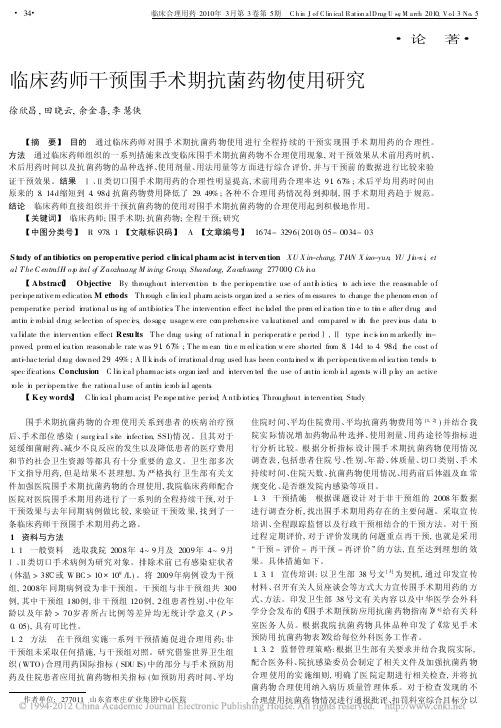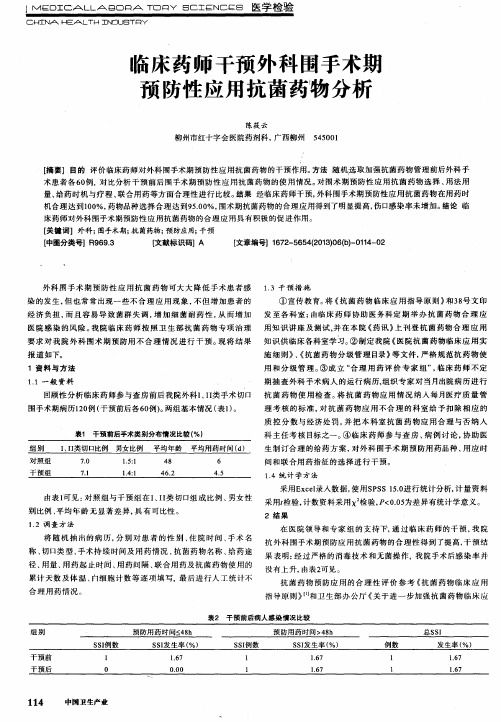围手术期药物干预
- 格式:ppt
- 大小:6.44 MB
- 文档页数:29

预防围手术期患者低体温最新共识围术期低体温是指由于围术期非医疗目的导致患者核心体温低于36℃的一种临床现象。
发生率为7%~90%,可导致诸多不良结局。
预防围术期低体温已成为加速康复外科的重要环节。
笔者特整理《围术期患者低体温防治专家共识(2023版)》中有关对围术期低体温风险评估与预测、常用的体温监测方法以及为患者提供具体保温措施等方面相关知识,做如下分享。
一、患者围术期发生低体温的危险因素患者围术期发生低体温的危险因素很多,主要包括患者因素、手术因素、麻醉因素(包括药物因素)、环境因素以及是否干预等,多重因素作用下,患者发生低体温的概率明显增加。
目前尚无强有力的证据表明任何单一因素会增加患者围术期低体温的发生率。
推荐意见:围术期患者因素、手术因素、麻醉因素和环境因素等以及是否采取干预措施是复合形成低体温的影响因素。
投票赞成率:100%。
二、围术期核心体温监测围术期患者体温监测主要为核心体温,而外周组织温度比核心体温低2~4℃。
临床患者体温监测的部位和技术方法对于发现和防治低体温十分重要。
本专家共识明确了患者体温监测的时机、频率和常用监测方法。
新型体温监测方法(如电子体温计和红外线体温计等)具有快速、精确、舒适的优势,已逐渐取代传统的水银体温计。
新型体温监测方法的精确性取决于测量部位,可实现连续监测和数据联网传输,使得围术期体温监测更实时、准确。
推荐意见:手术患者的体温监测应具有动态连续性,涵盖整个围术期,包括术前、术中和术后恢复期;术中需应用准确度高、成本低、创伤小且能够准确反映患者核心体温的体温测量方法与部位。
投票赞成率:100%。
三、围术期低体温防治措施体温管理目标:目前根据既往研究和临床指南,术中维持患者核心体温目标依旧定义为不低于36℃。
围术期低体温防治的具体措施主要包括:1、物理保温措施,主要分为被动保温、主动保温和增加环境温度。
2、药物干预措施推荐意见:结合患者热舒适度,手术患者的体温维持目标为36℃。



doi :10.3969/j.issn.1002-7386.2023.17.033·药物研究·医院Ⅰ类切口围手术期患者的抗菌药物使用情况与干预措施章新芬 段石明项目来源:皖南医学院校级科研项目(编号:JXYY202298)作者单位:244000 安徽省铜陵市立医院 【摘要】 目的 针对医院Ⅰ类切口围手术期的抗菌药物使用情况进行分析,汇总相关干预措施。
方法 选择2022年1~9月接受Ⅰ类切口手术患者的出院病历共983份,分析患者的一般资料、手术类型、抗菌药物类型以及可能存在的不合理使用情形。
结果 抗菌药物的预防使用率为30.5%,其中以骨折复位内固定术的比例最高;大部分为单独用药,头孢呋辛和头孢西丁的DUI 值>1,存在不合理使用现象;在300份预防使用抗菌药物的病历中,20.7%(62/300)存在不合理情形,如预防使用时长不适宜、预防使用时机不适宜和无用药指征等。
结论 医院Ⅰ类切口围手术期间抗菌药物的使用基本符合要求,这与医院专门针对于Ⅰ类切口围手术期间抗菌药物实施管理规定的相关干预管控措施密不可分;但仍存在部分不合理用药现象,今后应重点监管。
【关键词】 Ⅰ类切口;围手术期;抗菌药物;干预措施【中图分类号】 R 195 【文献标识码】 A 【文章编号】 1002-7386(2023)17-2700-03Use of antibiotics for patients with class I incisions during the perioperative period and the interventions ZHANG Xinfen ,DUAN Shiming.Tongling Municipal Hospital ,Anhui ,Tongling 244000,China【Abstract 】 Objective To analyze the use of antibiotics for patients with class I incisions during the perioperative period and to summarize the interventions.Methods A total of 983discharged medical records of surgical patients with class I incision in our hospital from January to September 2022were selected to analyze the general clinical data ,types of surgery ,types of antibiotics and possible irrational use of antibiotics.Results The rate of prophylactic use of antibiotics was 30.5%,and the majority was used for fracture reduction and internal fixation.Most of the use of antibiotics was a monotherapy.The drug utilization index (DUI )of cefuroxime and cefoxitin was greater than 1,indicating an unreasonable use.Among 300medical records of prophylactic use of antibiotics ,20.7%(62/300)had unreasonable situations like an inappropriate duration of prophylactic use ,inappropriate time of prophylactic use and no medication indication.Conclusion The use of antibiotics in class I incisions in our hospital during the perioperative period basically meets the requirements ,which is closely related to the targeted intervention and control measures in our hospital.However ,there are still some cases of unreasonable use ,which should be mainly focused in the future.【Key words 】 class I incision ;perioperative period ;antibiotics ;interventions 依据《抗菌药物临床应用指导原则(2015年版)》[1]中的相关规定,Ⅰ、Ⅱ、Ⅲ和Ⅳ类手术切口分别对应清洁手术、清洁⁃污染手术、污染手术、污秽⁃感染手术。

#论 著#临床药师干预围手术期抗菌药物使用研究徐欣昌,田晓云,余金喜,李慧侠作者单位:277011 山东省枣庄矿业集团中心医院=摘 要> 目的 通过临床药师对围手术期抗菌药物使用进行全程持续的干预实现围手术期用药的合理性。
方法 通过临床药师组织的一系列措施来改变临床围手术期抗菌药物不合理使用现象,对干预效果从术前用药时机、术后用药时间以及抗菌药物的品种选择、使用剂量、用法用量等方面进行综合评价,并与干预前的数据进行比较来验证干预效果。
结果 Ñ、Ò类切口围手术期用药的合理性明显提高,术前用药合理率达91.67%;术后平均用药时间由原来的8.14d 缩短到4.98d ,抗菌药物费用降低了29.49%;各种不合理用药情况得到抑制,围手术期用药趋于规范。
结论 临床药师直接组织并干预抗菌药物的使用对围手术期抗菌药物的合理使用起到积极地作用。
=关键词> 临床药师;围手术期;抗菌药物;全程干预;研究=中图分类号> R 978.1 =文献标识码> A =文章编号> 1674-3296(2010)05-0034-03S tudy of an tibiotics on p erop erative period c li n ical phar m ac ist i n terven tion XU X in -chang,T IAN X iao-yun ,YU J i n-x i ,et al .T he C entralH o s p ital of Zaozhuang M ining Group,Shandong,Zaozhuang 277000,Ch i na =Abstract > O bjective By throughout i nterventi on t o the per i opera ti ve use o f anti b i o tics ,t o ach ieve the reasonable o f per i ope rative m edicati on .M ethods T hrough c li n ica l phar m acists organ ized a se ries of m easures to change the phenom enon o f peroperati ve per i od i rrati ona l us i ng of anti biotics .T he interventi on e ffect i nc l uded the pre m ed i ca tion ti m e to ti m e after drug ,and anti m i c robial drug se lecti on of spec i es ,do sag e ,usage w ere co m prehensive va l uati oned and compared w it h t he prev i ous data t o va li date the i ntervention e ffect .Resu lts T he drug usi ng o f rationa l i n perioperati v e pe ri od Ñ,Òtype i nc i s i on m arkedly i m -proved ,pre m ed ica ti on reasonab le rate was 91.67%;T he m ean ti m e m ed i ca tion w ere sho rted from 8.14d to 4.98d ,t he cost o f ant-i bac terial drug downed 29.49%;A ll k i nds o f irrati onal drug used has been conta i ned w it h per i opera tive m ed ica ti on tends t o spec ifi cations .Conclusion C li n i ca l pharmac ists organ ized and i nterven ted the use o f anti m icrob i a l agents w ill p l ay an active ro le i n per i opera ti ve t he rati ona l use o f anti m icrob i a l agents .=K ey words > C li n ica l phar m acist ;Pe rope rative per i od ;A nti b i otics ;Throughout i n terventi on ;Study 围手术期抗菌药物的合理使用关系到患者的疾病治疗预后、手术部位感染(surg i ca l site i nfecti on ,SSI)情况。

肛门直肠瘘简称肛瘘,是发生在肛门直肠周围的脓肿溃破或切口引流的后遗病变,可单发或多发,目前国内肛瘘患者大约占肛肠病的1.67%~3.60%,国外约8%~25%[1]。
肛瘘形成后无自愈性,可反复发作,严重影响患者的日常生活。
因此,肛瘘患者必须接受手术治疗[2]。
肛瘘切除术为Ⅲ类切口手术,以充分暴露瘘管、切除与引流为基础,存在术后手术创面大,愈合时间长等问题[3],且手术切口会涉及消化道排泄物的暴露,增加手术部位感染的风险。
因此,如何加强术后切口感染的防控,是促进肛瘘手术伤口愈合的重要举措之一。
预防围手术期切口感染,可从人员、设备、手术所用敷料、器械、手术环境、手术水平等方面综合管理[4]。
其中,抗菌药物在围手术期切口感染的预防中发挥了重要作用,但由于全球多重耐药菌的紧迫形势,围手术期抗菌药物的规范使用是一项重要课题。
肛瘘围手术期抗菌药物使用率较高,使用品种复杂,使用剂量不规范且疗程较长[5-6],因此,对肛瘘围手术期抗菌药物的管理至关重要。
2015年版《抗菌药物临床应用指导原则》[7]已对结直肠手术围手术期的抗感染治疗给出了指导性意见,但尚未细分不同病种及亚型、不同手术类型的给药方案。
同时,抗菌药物的合理使用需要多部门、多学科共同合作管控[8]。
故本研究采用临床药师主导、医务处、感管科、医疗质量管理办公室及临床医生共同参与的抗菌药物科学化管理(antimicrobial stewa-rdship ,AMS )干预模式[9],分析我院肛肠科肛瘘围手术期抗菌药物不规范使用存在的根本原因,建立长效的肛瘘围手术期抗菌药物使用的管理机制。
1资料与方法1.1一般资料选取2018年7月~9月于南京中医药大学附属南京中医院肛肠科行肛瘘手术并接受住院治疗的患者95例为干预前组,2018年10月~12月期间患者104例为干预后组。
两组患者的年龄、性别、感染高危因素(年龄超过65岁、糖尿病控制不佳、免疫缺陷、长期服用免疫抑制剂、血液系统疾病或营养不良的患者)差异无统计学意义(P >0.05),具有可比性。
子宫肌瘤切除围手术期预防应用抗菌药物干预的分析叶峥嵘;吴琳【摘要】Objective To estimate the intervention effects of clinical pharmacists on the use of antibiotics during perioperative period of myomectomy .Methods The clinical data were collected from 50 patients with myomectomy from July to December in 2013 (before intervention) and 50 patients from January to June in 2014(after intervention) .The rationality of antibiotics application was evaluated thereafter .Results The use rate of antibiotics was 100% before and after the intervention .After intervention by clinical pharmacists ,the combined medication rate declined from 70% to 64% ;the rate of rational variety choice increased from 78 .0% to 100 .0% ;the rate of rational course of treatment was improved from 10 .0% to 58 .0% ,with statistical significance(P<0 .05) .The proportion of the total drug cost accounting for the total cost of hospitalization decreased from 30 .0% to 27 .3% ,and the percentage of total antibiotics expense in the total medicine expense decreased from32 .0% to 23 .0% .The mean hospitalization stay per patient decreased1 .08 days .Conclusion The preventive use of antibiotics in sterile surgery during perioperative period by the clinical pharmacists is feasible and effective ,which could improve the level of rational antibiotic use and decrease the hosital stay and expenses .%目的:评价临床药师干预子宫肌瘤切除术患者围手术期抗菌药物应用的效果。